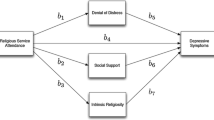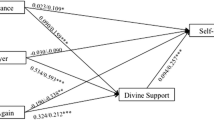Abstract
The effects of religious support, maternal motivations for having large families, and their interactions on psychological functioning were assessed in a sample of 79 religious Israeli Jewish mothers of six or more children. Religious support from religious leaders, community, and G-d—as well as faith-focused maternal motivation—were all positively related to adaptive psychological functioning. In contrast, self-focused maternal motivation was negatively related to adaptive functioning. Moreover, religious support and maternal motivation were both related to psychological functioning even after controlling for social support. Finally, several significant interactions between religious support and maternal motivation emerged and are also discussed.


Similar content being viewed by others
References
Allport, G. W., & Ross, J. M. (1967). Personal religious orientation and prejudice. Journal of Personality and Social Psychology, 5, 423–443.
Anson, J., & Meir, A. (2007). Religiosity, nationalism and fertility in Israel. In J. Schellekens & J. Anson (Eds.), Israel’s destiny: Fertility and mortality in a divided society (pp. 29–52). New Brunswick, N.J: Transaction Publications.
Antonovsky, A. (1993). The structure and properties of the sense of coherence scale. Social Science and Medicine, 36, 725–733.
Antonovsky, A., & Sourani, T. (1988). Family sense of coherence and family adaptation. Journal of Marriage and Family, 50, 79–92.
Bassarath, L. (2001). Conduct disorder: A biopsychosocial review. The Canadian Journal of Psychiatry, 46, 609–616.
Benyamini, Y., & Lomranz, J. (2004). The relationship of activity restriction and replacement with depressive symptoms among older adults. Psychology and Aging, 19, 362–366.
Bjorck, J. P., Braese, R. W., Tadie, J. T., & Gililland, D. D. (in press). The Adolescent religious coping scale: Development, validation, and cross-validation. Journal of Child and Family Studies.
Blumstein, T., Benyamini, Y., Fuchs, Z., Shapira, Z., Novikov, I., Walter-Ginzburg, A., et al. (2004). The effect of a communal lifestyle on depressive symptoms in late life. Journal of Aging and Health, 16, 151–174.
Brisson, C., Laflamme, N., Moisan, J., Milot, A., Masse, B., & Vezina, M. (1999). Effect of family responsibilities and job strain on ambulatory blood pressure among white-collar women. Psychosomatic Medicine, 61, 205–213.
Brown, G. W., & Harris, T. (1978). The social origins of depression. New York: The Free Press.
Calzeroni, A., Conte, G., Terzi, A., & Vita, A. (1989). Fertility and marital status in mood disorders: Relationship with age at onset. New Trends in Experimental & Clinical Psychiatry, 5, 87–90.
Calzeroni, A., Conte, G., Terzi, A., Vita, A., & Sacchetti, E. (1990). Celibacy and fertility rates in patients with major affective disorders: The relevance of delusional symptoms and suicidal behavior. Acta Psychiatrica Scandinavica, 82, 309–310.
Caserta, M. S., Lund, D. A., & Gray, R. M. (1987). Vulnerability factors and depressive symptoms among hospitalized women. Journal of Community Psychology, 15, 216–227.
Cassidy, T., & Sintrovani, P. (2008). Motives for parenthood, psychosocial factors and health in women undergoing IVF. Journal of Reproductive and Infant Psychology, 26, 4–17.
Chen, G., & Ployhart, R. E. (2006). Technical Report 1180: An interactionalist analysis of soldier retention across career stages and time. United States Army Research Institute for the Behavioral and Social Sciences.
Colpin, H., De Munter, A., & Vandemeulebroecke, L. (1998). Parenthood motives in IVF-mothers. Journal of Psychosomatic Obstetrics and Gynecology, 19, 19–27.
Cutrona, C. E., & Russell, D. W. (1987). The provision of social relationships and adaptation to stress. In W. H. Jones & D. Perlman (Eds.), Advances in personal relationships (Vol. 1, pp. 27–67). Greenwich, CT: JAI Press.
Diener, E., Emmons, R. A., Larsen, R. J., & Griffin, S. (1985). The satisfaction with life scale. Journal of Personality Assessment, 49, 71–75.
Ellison, C. G. (1991). Religious involvement and subjective well-being. Journal of Health and Social Behavior, 32, 80–99.
Ellison, C. G., Gay, D. A., & Glass, T. A. (1989). Does religious commitment contribute to individual life satisfaction? Social Forces, 68, 100–123.
Eriksson, M., & Lindström, B. (2007). Antonovsky’s sense of coherence scale and its relation with quality of life: A systematic review. Journal of Epidemiology and Community Health, 61, 938–944.
Fiala, W. E., Bjorck, J. P., & Gorsuch, R. (2002). The religious support scale: Construction, validation, and cross-validation. American Journal of Community Psychology, 30, 761–786.
Frenz, A. W., Carey, M. P., & Jorgensen, R. S. (1993). Psychometric evaluation of Antonovsky’s sense of coherence scale. Psychological Assessment, 5, 145–153.
George, L. K., Ellison, C. G., & Larson, D. B. (2002). Explaining relationships between religious involvement and faith. Psychological Inquiry, 13, 190–200.
Gerson, M. J. (1983). A scale of motivation for parenthood: The index of parenthood motivation. Journal of Psychology: Interdisciplinary and Applied, 113, 211–220.
Gormly, A. V., Gormly, J. B., & Weiss, H. (1987). Motivations for parenthood among young adult college students. Sex Roles, 16, 31–39.
Gorsuch, R. L. (1983). Factor analysis. City, NJ: Lawrence Erlbaum.
Gorsuch, R. L. (1991). UniMult for univariate and multivariate data analysis. Altadena, CA: UniMult.
Haber, M. G., Cohen, J. L., Lucas, T., & Baltes, B. (2007). The relationship between self-reported received and perceived social support: A meta-analytic review. American Journal of Community Psychology, 39, 133–144.
Heiman, T. (2004). Examination of the salutogenic model, support resources, coping style, and stressors among Israeli university students. Journal of Psychology, 138, 505–520.
Israeli Central Bureau of Statistics (2007). Survey table generator. Retrieved March 3, 2009 from http://surveys.cbs.gov.il/Survey/ surveyE.htm.
Kirchengast, S. (1992). Relations between fertility, body shape and menopause in Austrian women. Journal of Biosocial Science, 24, 555–559.
Koenig, H. G. (1995). Religion and older men in prison. International Journal of Geriatric Psychiatry, 10, 219–230.
Langdridge, D., Connolly, K., & Sheeran, P. (2000). Reasons for wanting a child: a network analytic study. Journal of Reproductive and Infant Psychology, 18, 321–338.
Lazar, A., & Bjorck, J. P. (2008). Religious support and psychosocial well-being among a religious Jewish population. Mental Health, Religion, and Culture, 11, 403–421.
Lev-Wiesel, R. (1998). Coping with the stress associated with forced relocation in the Golan Heights, Israel. Journal of Applied Behavioral Science, 34, 143–160.
Loewenthal, K., Goldblatt, V., Gorton, T., Lubitsch, G., Bicknell, H., Fellowes, D., et al. (1995). Gender and depression in Anglo-Jewry. Psychological Medicine, 25, 1051–1064.
Loewenthal, K. M., Goldblatt, V., Gorton, T., Lubitsch, G., Bicknell, H., Fellowes, D., et al. (1997). The social circumstances of anxiety and its symptoms among Anglo-Jews. Journal of Affective Disorders, 46, 86–94.
Loewnthal, K. M., & Goldblatt, V. (1993). Family size and depressive symptoms in Orthodox Jewish women. Journal of Psychiatric Research, 27, 3–10.
Maltby, J., & Day, L. (2000). Depressive symptoms and religious orientation: Examining the relationship between religiosity and depression within the context of other correlates of depression. Personality and Individual Differences, 28, 383–393.
Maynard, E., Gorsuch, R., & Bjorck, J. (2001). Religious coping style, concept of God, and personal religious variables in threat, loss and challenge situations. Journal for the Scientific Study of Religion, 40, 65–74.
Menaghan, E. G. (1999). Social stressors in childhood and adolescence. In T. L. Scheid & A. V. Horwitz (Eds.), A handbook for the study of mental health: Social contexts, theories, and systems (pp. 315–327). New York, NY, US: Cambridge University Press.
Myers, D. G., & Diener, E. (1995). Who is happy? Psychological Science, 6, 10–19.
O’Donovan, A., & Hughes, B. M. (2008). Factors that moderate the effect of laboratory-based social support on cardiovascular reactivity to stress. International Journal of Psychology and Psychological Therapy, 8, 85–102.
Ozbay, F., Johnson, D. C., Dimoulas, E., Morgan, C. A., Charney, D., & Southwick, S. (2007). Social support and resilience to stress: From neurobiology to clinical practice. Psychiatry, 4, 35–40.
Palmer, K. (2009). Nadya Suleman’s challenge: Paying for 14 kids. Retrieved February 19, 2009 from http://www.usnews.com/blogs/alpha-consumer/2009/2/9/nadya-sulemans-challenge-paying-for-14-kids.html.
Pargament, K. I., & Park, C. L. (1995). Merely a defense? The variety of religious means and ends. Journal of Social Issues, 51, 13–32.
Park, H., Murgatroyd, W., Raynock, D. C., & Spillet, M. A. (1998). Relationship between intrinsic-extrinsic religious orientation and depressive symptoms in Korean Americans. Counseling Psychology Quarterly, 11, 315–324.
Radloff, L. S. (1977). A self report depression measure for research in general population. Applied Psychological Measurement, 1, 384–401.
Saad, L. (2006). Attitudes toward family size among Palestinians and Israelis. Retrieved May 5, 2009, www.gallop.com/poll/21940/Attitudes- toward- family- size- among- Palestinians- and- Israelis.
Spielberger, S. D. (1976). Trait-State questionnaire. In H. Teichman, & H. Malinek (Eds.) and Trans.). Tel-Aviv, Israel: Psychology Department, Tel-Aviv University [Hebrew].
Takizawa, T., Kondo, T., Sakihara, S., Ariizumi, M., Watanabe, N., & Oyama, H. (2006). Stress buffering effects of social support on depressive symptoms in middle age: Reciprocity and community mental health. Psychiatry and Clinical Neurosciences, 60, 652–661.
Teichman, Y., & Malinek, H. (1979). State-trait anxiety questionnaire, translation and modification to Hebrew. Tel Aviv, Israel: Department of Psychology, Tel Aviv University.
United Nations (2007). World fertility patterns 2007. Retrieved February 19, 2009 from http://www.un.org/esa/population/publications/worldfertility2007/worldfertility2007.htm: Author.
Volanen, S.-M., Suominen, S., Lahelma, E., Koskenvuo, M., & Silventoinen, K. (2007). Negative life events and stability of sense of coherence: A five-year follow-up study of Finnish women and men. Scandinavian Journal of Psychology, 48, 433–441.
Waddell, E. N., & Messeri, P. A. (2006). Social support, disclosure, and use of antiretroviral therapy. AIDS and Behavior, 10, 263–272.
Ware, J. E., & Sherbourne, C. D. (1992). The MOS 36-item short-form health survey (SF-36): I. Conceptual framework and item selection. Medical Care, 30, 473–483.
Weiss, R. (1974). The provisions of social relationships. In Z. Rubin (Ed.), Doing unto others (pp. 17–26). Englewood Cliffs, NJ: Prentice Hall.
Weissman, M. M., Wickramaratne, P., Merikangas, K. R., Leckman, J. F., Prusoff, B. A., Caruso, K. A., et al. (1984). Onset of major depression in early adulthood: Increased familial loading and specificity. Archives of General Psychiatry, 41, 1136–1143.
Whipple, E. E. (2006). Child abuse and neglect: Consequences of physical, sexual, and emotional abuse of children. In B. Zuckerman, H. E. Fitzgerald, & B. M. Lester (Eds.), The crisis in youth mental health: Critical issues and effective programs, Vol 1: Childhood disorders (pp. 205–229). Westport, CT, US: Praeger Publishers/Greenwood Publishing Group.
Willoughby, M. T., Cadigan, R. J., Burchinal, M., & Skinner, D. (2008). An evaluation of the psychometric properties and criterion validity of the religious social [sic] support scale. Journal for the Scientific Study of Religion, 47, 147–159.
Winemiller, D. R., Mitchell, M. E., Sutliff, J., & Cline, D. J. (1993). Measurement strategies in social support: A descriptive review of the literature. Journal of Clinical Psychology, 49, 638–648.
Zimet, G. D., Dahlem, M. W., Zimet, S. G., & Parley, G. K. (1988). The multidimensional scale for perceived social support. Journal of Personality Assessment, 52, 30–41.
Author information
Authors and Affiliations
Corresponding author
Rights and permissions
About this article
Cite this article
Bjorck, J.P., Lazar, A. Religious Support, Motives for Having Large Families, and Psychological Functioning Among Religious Jewish Mothers. J Relig Health 50, 177–194 (2011). https://doi.org/10.1007/s10943-009-9294-2
Published:
Issue Date:
DOI: https://doi.org/10.1007/s10943-009-9294-2




